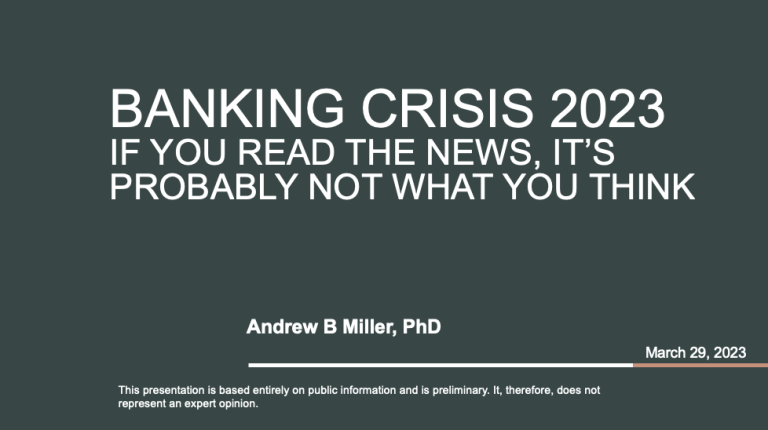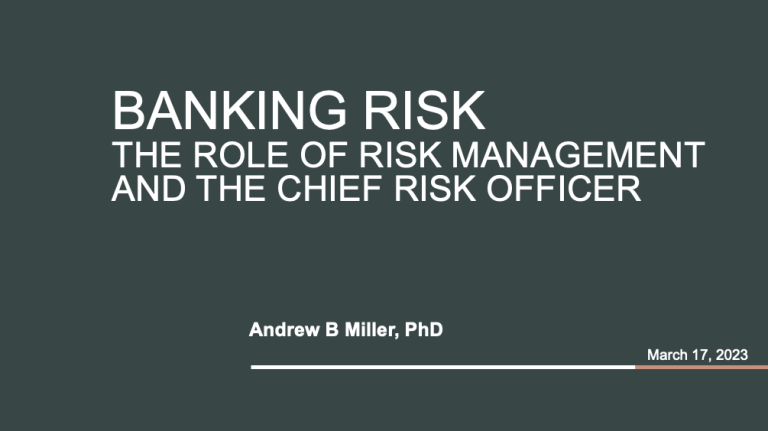...or scroll down to see our latest publications on the Banking Crisis of 2023.
What caused the recent banking crisis? If you read the news, it’s probably not what you think - coordinated runs, fin tech, short sellers, valuation errors and surprises, adventures in GAAP, the Fed, lemons, and hold up problems.
"The autopsy cannot be concluded until SVB's unprecedented and coordinated bank run is understood at the cellular level."
Andrew B. Miller, PhD, 3/20/23
Poor risk management is becoming the consensus narrative but is that correct? All banks' risk management can be criticized ex post. Only some banks failed. So what really happened?
Bank Risk Monitor on the Banking Crisis of 2023
This presentation analyzes the current banking crisis beginning with the failure of Silicon Valley Bank. It presents a reasoned explanation for the cause of SVB's failure and the contagion to other banks. The presentation focusses on the main stakeholders and considers whether the Fed's accusation that poor risk management at SVB (and possibly at other banks) is the underlying cause of the crisis. This upload is a summary, please contact me for the full presentation. Click on the image at left to download.
In this non-technical presentation, I examine the role of the chief risk officer in managing banking risk under in the recent environment and the emerging banking crisis. I give an overview based on my experience assessing risks in financial services corporations and use examples from recent bank failures and wobbles including; Silicon Valley Bank, Signature Bank, First Republic Bank, and Comerica Bank, among others. Click on the image at left to download.
Fed Official Calls Silicon Valley Bank Failure a ‘Textbook Case of Mismanagement’ WSJ 3/24/23
“SVB failed because the bank’s management did not effectively manage its interest rate and liquidity risk, and the bank then suffered a devastating and unexpected run by its uninsured depositors,” said Michael Barr, the Fed’s vice chairman for supervision, in written testimony released by the central bank.
The Fed is not mincing words, it places the blame on the executives and the board.
What does that mean for your bank?
The Banking Crisis Landscape
Silicon Valley Bank’s risk model flashed red. So its executives changed it. Washington Post 4/2/23
SVB hired a consultant, Curinos, to review its interest-rate risk model, according to the former employees. The bank first disclosed the review of its model in May and finalized the change in the second quarter of 2022. But by the end of the year, SVB left out the economic value of equity — which it had reported for a decade — from its public interest-rate analysis.
Curinos declined to comment on whether it did any work for SVB, adding in a statement that the company works with banks and “routinely analyzes customer behavior to assess the likelihood that their balances will change based on different stimuli, such as interest rates.”
Is your bank relying on outside consultants to assess liquidity risks? If so, are they "hitting the mark"? SVB's depositors were quite different than the average retail depositor.
SVB Is One More Example Of A Governance Crisis That Seems To Be Only Foretold By Short Sellers, Despite Plenty Of Red Flags Hiding In Plain Sight, Forbes, 3/15/23
Short interest in SVB, as per NASDAQ data, reveals a fascinating pattern. It jumps by 55% to 638,000 shares on 1/31/22 and again by 26% to 805,000 shares on 2/15/22. By 6/30/22, the date by which I thought SVB was functionally bankrupt, short interest has climbed to 1.87 million shares. Short interest peaks at 4 million shares on 1/15/23 and stood at 3.2 million shares on 2/28/22, the latest date for which I could find data.
Is your bank being targeted by short sellers? If so, why and what is that doing to your client and investor bases?
Auditors Didn't Flag Risks Building Up in Banks WSJ 4/10/23
When KPMG LLP gave Silicon Valley Bank a clean bill of health just 14 days before the lender collapsed, the Big Four audit firm flagged potential losses on loans as a so-called critical audit matter. But the audit opinion was silent on what actually brought down the bank—its unrealized bond losses and ability to hold them given a reliance on potentially flighty deposits.
“The auditors failed to mention the fire in the basement or the box of dynamite on the first floor, but they did point out the peeling paint on the flower box,” said Erik Gordon, a University of Michigan business professor. “How could they miss the interest-rate risk?” ...
Auditors’ apparent blind spot on the interplay of interest-rate and liquidity risks isn’t confined to Silicon Valley Bank.
Auditors for nine other U.S. banks most exposed to bond losses also didn’t flag this as an issue when they signed off on the financial statements for 2022, according to an analysis by The Wall Street Journal.
The Journal reviewed the audit opinions for the 10 small to midsize U.S. banks that last year reported the highest losses on held-to-maturity securities as a proportion of their shareholder equity, based on data from research-firm Calcbench. Silicon Valley Bank ranked second on the list.
None of the auditors included a critical audit matter related to the bank’s treatment of the bonds. Instead, nine of the 10 reported a critical audit matter for estimated losses from loans or other bad debts. That is the risk that brought down banks in the 2008 financial crisis. Auditors didn’t report any critical audit matter for one of the banks, the analysis found.
Auditors are neither independent nor well-suited to give opinions on measuring risks. Furthermore, another critical issue for SVB was the valuation of its AFS and HTM portfolios.
The market sale of the AFS portfolio to Goldman Sachs, showed that both the bank and its auditors may have erred on the AFS valuation. This error could be viewed as the spark that led to the bank run.
Is your bank sitting on undisclosed valuation surprises?



